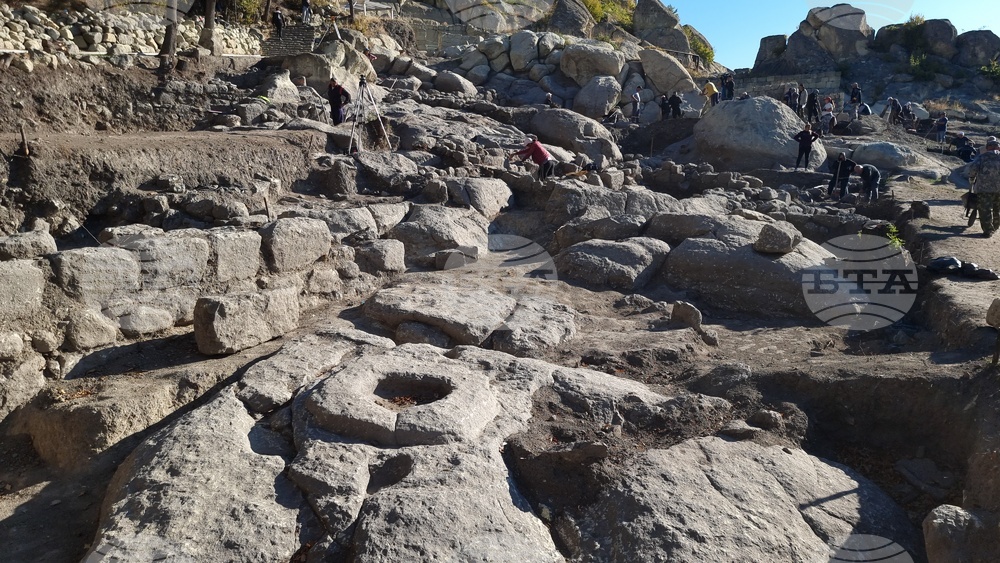site.btaUPDATED Asteroid Named After Ancient Thracian City of Perperikon


On February 24, an asteroid located between Jupiter and Mars was named Perperikon, after the ancient Thracian city of Perperikon, Eastern Rhodopes, with the name being approved by the Working Group for Small Bodies Nomenclature (WGSBN) of the International Astronomical Union, archaeologist Prof. Nikolay Ovcharov, the long-time head of excavations at Perperikon, told BTA.
Assoc. Prof. Veselka Radeva, head of the planetarium at the Nikola Vaptsarov Naval Academy in Varna, explained that it was discovered in 2015 in Varna during work with students from various schools as part of an international astronomical scientific research programme for discovering and tracking asteroids. It was Radeva who discovered the asteroid while working on the programme together with student Irena Dimitrova from the High School of Mathematics in Varna.
The asteroid is part of a belt orbiting the Sun between Mars and Jupiter, taking about 5 years and 8–9 months to complete its orbit, Radeva said. According to her, it is yet to be studied to determine its rotational period, size, and chemical composition. Such observations are conducted using the telescopes at the Rozhen National Astronomical Observatory.
During the training in Varna in 2015, other asteroids were also discovered, and some of them are still awaiting their names, Radeva added. She explained that the naming process is very slow because the celestial body must be observed throughout its entire orbit before the discoverer is given the opportunity to name it.
Assoc. Prof. Radeva proposed the name Perperikon because the megalithic archaeological complex is important to every Bulgarian, and every corner of it holds a rich history. She has been taking young astronomers there every year since 2000 to follow the work of Prof. Nikolay Ovcharov's team. "Their favourite spot is a niche they call 'The Solar Observatory', where they believe people in the past observed the solstices and performed rituals marking the changing of the seasons," she further explained.
Assoc. Prof. Radeva recalled that more than 200 asteroids discovered by Bulgarians have been given Bulgarian names. Among them is the asteroid Varna, which was detected about two years ago.
WGSBN Secretary Gareth Williams confirmed that the minor planet 560085 was officially given the name Perperikon on February 24. Williams explained that whoever is defined as the discoverer of a specific minor planet can propose a name for that object. "It is not required that all minor planets have names. Discoverers make their proposals, submitting both a proposed name and a proposed citation explaining the reasons for the naming, through a website that the WGSBN operates. The Working Group Small Body Nomenclature consists of 11 voting members, who vote to accept or reject the proposals. Every three weeks, the WGSBN publishes a new issue of the WGSBN Bulletin, containing newly-approved names and citations. Once a Bulletin is published, the names therein become official," he told BTA.
The WGSBN Bulletin says that 560085 was named Perperikon after the largest megalithic archaeological complex in the Balkans.
Speaking to BTA, Prof. Ovcharov reminded that the British daily The Guardian ranks Perperikon among the top ten most remarkable sites in Europe, while the U.S. tourism website www.islands.com, a part of National Geographic, refers to the ancient city as the 'Machu Picchu Of Europe'.
"We should pay much more attention to these monuments we have, which are admired by the entire world. I am not saying that no attention is given, of course. But the attention should be much greater because our archaeological sites are capable of having an impact worldwide. This is extremely important, especially for the development of cultural tourism in Bulgaria," Ovcharov further emphasized.
/MR/
news.modal.header
news.modal.text